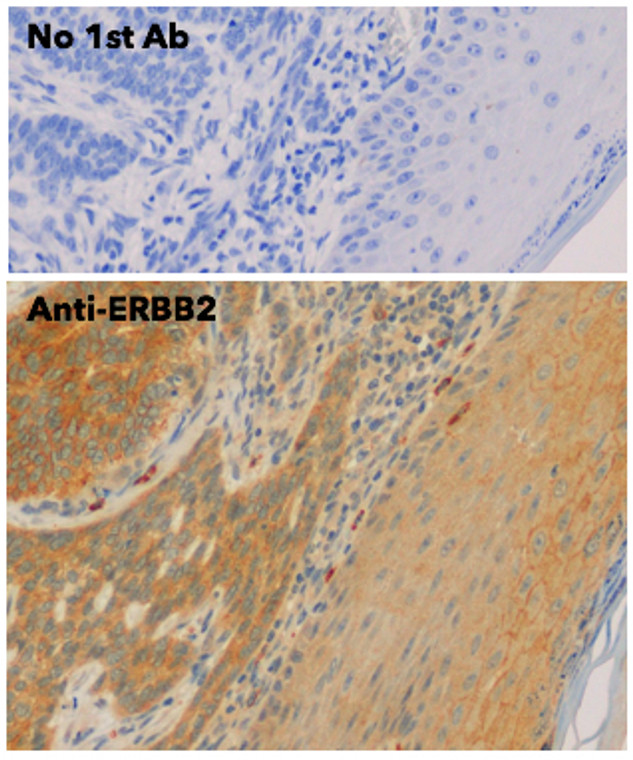| Host: | Goat |
| Applications: | WB/IHC-F/IHC-P |
| Reactivity: | Human/Rat/Mouse/Monkey/Canine |
| Note: | STRICTLY FOR FURTHER SCIENTIFIC RESEARCH USE ONLY (RUO). MUST NOT TO BE USED IN DIAGNOSTIC OR THERAPEUTIC APPLICATIONS. |
| Short Description: | Goat polyclonal antibody anti-Erb-b2 receptor tyrosine kinase (1177aa C-Term) is suitable for use in Western Blot, Immunohistochemistry and Immunohistochemistry research applications. |
| Clonality: | Polyclonal |
| Conjugation: | Unconjugated |
| Isotype: | IgG |
| Formulation: | PBS, 20% Glycerol and 0.05% Sodium Azide. |
| Purification: | This antibody is epitope-affinity purified from goat antiserum. |
| Concentration: | 3 mg/ml |
| Dilution Range: | WB 1:500-1:5000IHC-F 1:250-1:1000IHC-P 1:250-1:1000 |
| Storage Instruction: | For continuous use, store at 2-8 C for one-two days. For extended storage, store in-20 C freezer. Working dilution samples should be discarded if not used within 12 hours. |
| Gene Symbol: | ERBB2 |
| Gene ID: | 2064 |
| Uniprot ID: | ERBB2_HUMAN |
| Immunogen Region: | 1177aa C-Term |
| Accession Number: | ENSG00000141736 |
| Specificity: | Detects endogenous levels of ERBB2 by Western blot. |
| Immunogen: | Purified recombinant peptide derived from within residues 1, 177 aa to the C-terminus of human ERBB2 produced in E. coli. |
| Immunogen Sequence: | MPHPPPAFSPAFDNLYYWDQ DPPERGAPPSTFKGTPTAEN PEYLGLDVPV |
| Tissue Specificity | Expressed in a variety of tumor tissues including primary breast tumors and tumors from small bowel, esophagus, kidney and mouth. |
| Post Translational Modifications | Autophosphorylated. Autophosphorylation occurs in trans, i.e. one subunit of the dimeric receptor phosphorylates tyrosine residues on the other subunit (Probable). Ligand-binding increases phosphorylation on tyrosine residues. Signaling via SEMA4C promotes phosphorylation at Tyr-1248. Dephosphorylated by PTPN12. |
| Function | Protein tyrosine kinase that is part of several cell surface receptor complexes, but that apparently needs a coreceptor for ligand binding. Essential component of a neuregulin-receptor complex, although neuregulins do not interact with it alone. GP30 is a potential ligand for this receptor. Regulates outgrowth and stabilization of peripheral microtubules (MTs). Upon ERBB2 activation, the MEMO1-RHOA-DIAPH1 signaling pathway elicits the phosphorylation and thus the inhibition of GSK3B at cell membrane. This prevents the phosphorylation of APC and CLASP2, allowing its association with the cell membrane. In turn, membrane-bound APC allows the localization of MACF1 to the cell membrane, which is required for microtubule capture and stabilization. In the nucleus is involved in transcriptional regulation. Associates with the 5'-TCAAATTC-3' sequence in the PTGS2/COX-2 promoter and activates its transcription. Implicated in transcriptional activation of CDKN1A.the function involves STAT3 and SRC. Involved in the transcription of rRNA genes by RNA Pol I and enhances protein synthesis and cell growth. |
| Protein Name | Receptor Tyrosine-Protein Kinase Erbb-2Metastatic Lymph Node Gene 19 ProteinMln 19Proto-Oncogene NeuProto-Oncogene C-Erbb-2Tyrosine Kinase-Type Cell Surface Receptor Her2P185erbb2Cd Antigen Cd340 |
| Database Links | Reactome: R-HSA-1227986Reactome: R-HSA-1250196Reactome: R-HSA-1251932Reactome: R-HSA-1257604Reactome: R-HSA-1306955Reactome: R-HSA-1358803Reactome: R-HSA-1963640Reactome: R-HSA-1963642Reactome: R-HSA-2219530Reactome: R-HSA-416572Reactome: R-HSA-5673001Reactome: R-HSA-6785631Reactome: R-HSA-6811558Reactome: R-HSA-8847993Reactome: R-HSA-8863795Reactome: R-HSA-8866910Reactome: R-HSA-9634285Reactome: R-HSA-9652282Reactome: R-HSA-9664565Reactome: R-HSA-9665233Reactome: R-HSA-9665244Reactome: R-HSA-9665245Reactome: R-HSA-9665246Reactome: R-HSA-9665247Reactome: R-HSA-9665249Reactome: R-HSA-9665250Reactome: R-HSA-9665251Reactome: R-HSA-9665348Reactome: R-HSA-9665686Reactome: R-HSA-9665737 |
| Cellular Localisation | Cell MembraneSingle-Pass Type I Membrane ProteinCell ProjectionRuffle MembraneInternalized From The Cell Membrane In Response To Egf StimulationIsoform 1: Cell MembraneEarly EndosomeCytoplasmPerinuclear RegionNucleusTranslocation To The Nucleus Requires EndocytosisProbably Endosomal Sorting And Is Mediated By Importin Beta-1/Kpnb1Also Detected In Vps35-Positive Endosome-To-Tgn Retrograde VesiclesIsoform 2: CytoplasmIsoform 3: Cytoplasm |
| Alternative Antibody Names | Anti-Receptor Tyrosine-Protein Kinase Erbb-2 antibodyAnti-Metastatic Lymph Node Gene 19 Protein antibodyAnti-Mln 19 antibodyAnti-Proto-Oncogene Neu antibodyAnti-Proto-Oncogene C-Erbb-2 antibodyAnti-Tyrosine Kinase-Type Cell Surface Receptor Her2 antibodyAnti-P185erbb2 antibodyAnti-Cd Antigen Cd340 antibodyAnti-ERBB2 antibodyAnti-HER2 antibodyAnti-MLN19 antibodyAnti-NEU antibodyAnti-NGL antibody |
Information sourced from Uniprot.org
12 months for antibodies. 6 months for ELISA Kits. Please see website T&Cs for further guidance













